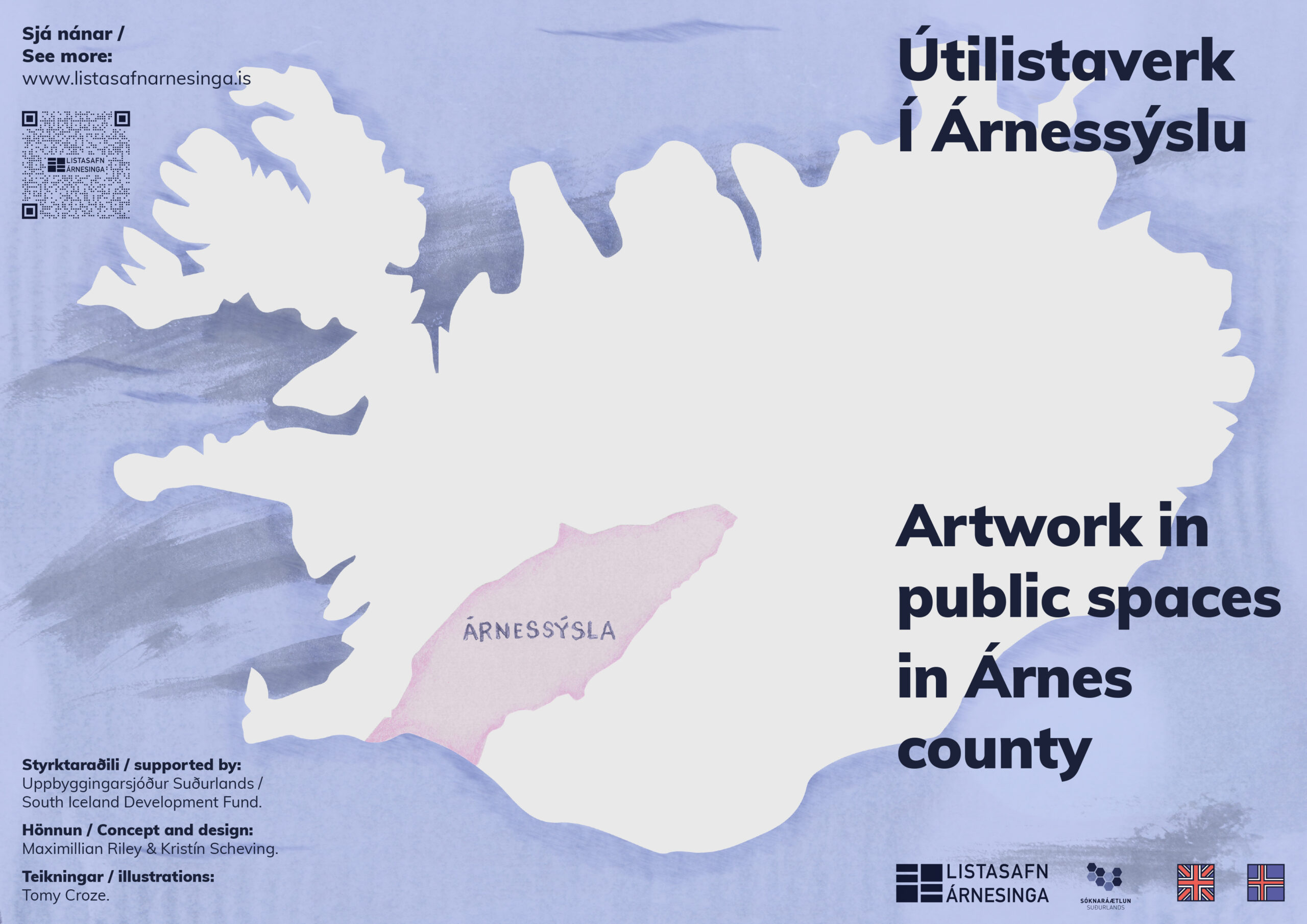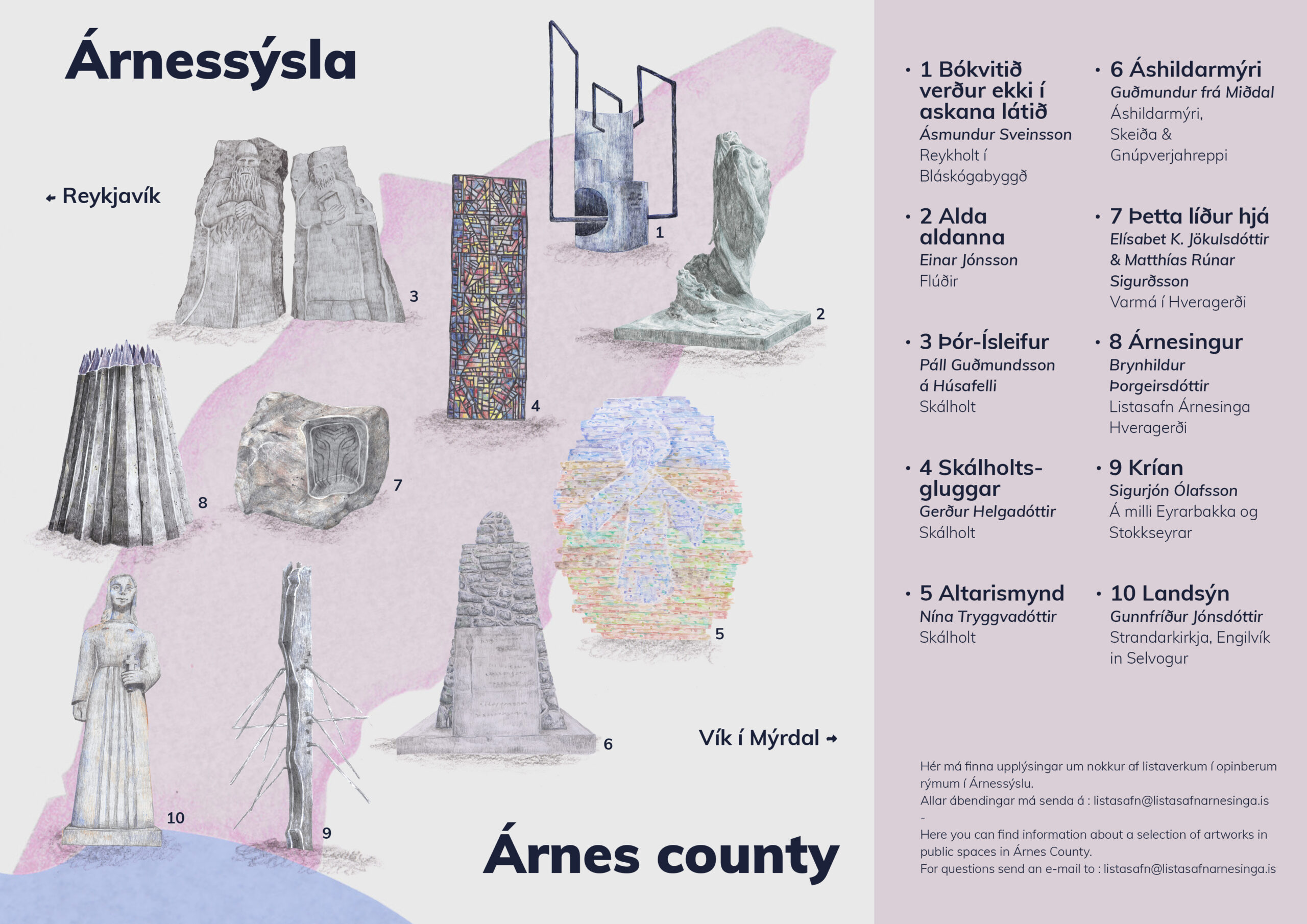
(Árnessýsla) can you find them?




Location: Reykholt í Bláskógabyggð
Year: Erected in 1958
Subject: Sculpture
Materials: Metal sculpture


Location: Flúðir
Year: 1905
Subject: sculpture
Materials: metal sculpture


Location: Skálholt
Year: 1997
Subject: Sculpture
Materials: Greywacke sculpture


Location: Skálholt *
Year: 1963
Subject: Stained glass window
Materials: Stained glass


Location: Skálholt *
Year: 1965
Subject: Mosaic work
Materials: Altarpiece


Location: Áshildarmýri á Skeiðum
Year: 1948
Subject: Sculpture
Materials: Stone structure, lava rocks, inscribed granite.


Matthías Rúnar Sigurðsson
Location: Varmá in Hveragerði
Year: 2019
Subject: Sculpture
Materials: Dolerite Sculpture.


Location: Listasafn Árnesinga
Year: 2018
Subject: sculpture


Location: Intersection between Stokkseyri and Eyrarbakki
Year: 1981
Subject: Sculpture
Materials: Metal sculpture


Location: Strandarkirkja við Engilvík í Selvogi.
Year: 1940
Subject: sculpture
Materials: granite sculpture
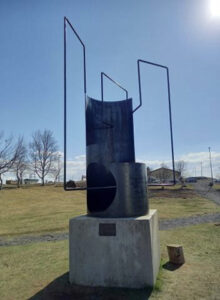 Artist: Ásmundur Sveinsson
Artist: Ásmundur Sveinsson
Location: Reykholt in Bláskógabyggð
Year: 1958
Subject: Sculpture
Materials: Metal sculpture
The Artwork:
Bókvitið verður ekki í askana látið is a tall metal sculpture located next to the community house Aratunga in Reykholt. The title comes from an old Icelandic saying: ‘Education cannot be fed to people, they must read and discover it for themselves’. The sculpture was a gift to celebrate Aratunga’s 60th birthday on the first day of summer in 1968.
The Artist:
Ásmundur Sveinsson (1893-1982) was one of Iceland’s pioneer sculptors. He started studying woodcarving in Reykjavík but continued his education in Copenhagen, Stockholm and finally in Paris, where he lived between 1926-1929. Ásmundur often worked with old sayings, many with references to reality or fairy tales, using his own unique way of interpreting them through his art.
At the beginning of his career he carved his sculptures from stone, often depicting his contemporaries, people working the hardest jobs for little or no money, for example a water bearer or a blacksmith. Around 1950 he met the artist Gerður Helgadóttir. Like her, Ásmundur became drawn to abstract works. From that time his style drastically changed, becoming bigger but also much lighter.
Ásmundur married Gunnfríður Jónsdóttir, a sculptor and a seamstress. They lived at Freyjugata 41 in downtown Reykjavík, next to Hallgrímskirkja, where there is now Ásmundarsalur gallery. After they divorced he built a unique home and a workshop in Sigtún. Today it is a museum and a sculpture garden in his name – Ásmundarsafn, and is a part of Reykjavík Art Museum. Ásmundur married his second wife, Ingrid Håkansson, in 1949. They had their first daughter 1941, one year before Ásmundur built the first part of his studio in Sigtún, Kúlan.
Concepts:
Abstract: Artform that is not bound to a specific object or being. The viewer does not see objects that they recognise, such as a flower or a car. The art is combined of forms, colours, or lines.
Sculpture: A three-dimensional artwork made from metal or carved in wood or stone.
Reflection:
How would you interpret a saying in art? How would you draw ‘education cannot be fed to people, they must read and discover it for themselves’.
Artist: Ásmundur Sveinsson 
Location: Reykholt in Bláskógabyggð
Year: 1958
Subject: Sculpture
Materials: Metal sculpture
The Artwork:
Bókvitið verður ekki í askana látið is a tall metal sculpture located next to the community house Aratunga in Reykholt. The title comes from an old Icelandic saying: ‘Education cannot be fed to people, they must read and discover it for themselves’. The sculpture was a gift to celebrate Aratunga’s 60th birthday on the first day of summer in 1968.
The Artist:
Ásmundur Sveinsson (1893-1982) was one of Iceland’s pioneer sculptors. He started studying woodcarving in Reykjavík but continued his education in Copenhagen, Stockholm and finally in Paris, where he lived between 1926-1929. Ásmundur often worked with old sayings, many with references to reality or fairy tales, using his own unique way of interpreting them through his art.
At the beginning of his career he carved his sculptures from stone, often depicting his contemporaries, people working the hardest jobs for little or no money, for example a water bearer or a blacksmith. Around 1950 he met the artist Gerður Helgadóttir. Like her, Ásmundur became drawn to abstract works. From that time his style drastically changed, becoming bigger but also much lighter.
Ásmundur married Gunnfríður Jónsdóttir, a sculptor and a seamstress. They lived at Freyjugata 41 in downtown Reykjavík, next to Hallgrímskirkja, where there is now Ásmundarsalur gallery. After they divorced he built a unique home and a workshop in Sigtún. Today it is a museum and a sculpture garden in his name – Ásmundarsafn, and is a part of Reykjavík Art Museum. Ásmundur married his second wife, Ingrid Håkansson, in 1949. They had their first daughter 1941, one year before Ásmundur built the first part of his studio in Sigtún, Kúlan.
Concepts:
Abstract: Artform that is not bound to a specific object or being. The viewer does not see objects that they recognise, such as a flower or a car. The art is combined of forms, colours, or lines.
Sculpture: A three-dimensional artwork made from metal or carved in wood or stone.
Reflection:
How would you interpret a saying in art? How would you draw ‘education cannot be fed to people, they must read and discover it for themselves’.
Artist: Einar Jónsson 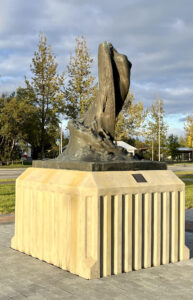
Location: Flúðir
Year: 1905
Subject: sculpture
Materials: metal sculpture
The Artwork:
The content of this artwork is inspired from the Greek myth of The Birth of Aphrodite. Aphrodite was the goddess of beauty and love. Here we see her rising from the sea, her hair and clothes fall tight on her body and from the hem of her dress we see images of other human beings being sucked up towards her chest. The figures at the bottom are vague and unclear, but as we move higher the clearer and more distinct they get. The one image that has made it up to her chest is the clearest of them all. Many people have read this as symbolism for those who work hard at life will reach to the top, while those who go with the current will not achieve much, they will just stay afloat.
The Artist:
Einar Jónsson was born in Galtafell in Árnessýsla in 1874. He was interested in art from a young age. In 1893 he sailed to Copenhagen to study woodcarving and sculpture. He stayed in Copenhagen until 1909 where he exhibited with the respected art group De Frie Billedhuggere (The Free Sculpturers). He also stayed in Rome for a year during this time. After his time in Copenhagen, he lived in Berlin and London until 1914. That same year, the Icelandic Parliament agreed to pay for transferring his art and sculptures from Copenhagen to Iceland and to preserve them in the future. A year later Parliament also agreed to fund the building of a museum that would house his art. That museum opened in the summer 1923 and was the first museum to be open to the Icelandic public. The Museum of Einar Jónsson, and its sculpture garden, is located at Skólavörðuholt in Reykjavík, next to Hallgrímskirkja.
Concepts:
Symbolism: Pictures or statues that represent ideas rather than an actual event.
Sculpture: A three-dimensional artwork made from metal, wood or stone.
Reflections:
What do you read from the sculpture? What do you think it symbolizes?
Do you know where the Einar Jónsson musem is?
Artist: Einar Jónsson 
Location: Flúðir
Year: 1905
Subject: sculpture
Materials: metal sculpture
The Artwork:
The content of this artwork is inspired from the Greek myth of The Birth of Aphrodite. Aphrodite was the goddess of beauty and love. Here we see her rising from the sea, her hair and clothes fall tight on her body and from the hem of her dress we see images of other human beings being sucked up towards her chest. The figures at the bottom are vague and unclear, but as we move higher the clearer and more distinct they get. The one image that has made it up to her chest is the clearest of them all. Many people have read this as symbolism for those who work hard at life will reach to the top, while those who go with the current will not achieve much, they will just stay afloat.
The Artist:
Einar Jónsson was born in Galtafell in Árnessýsla in 1874. He was interested in art from a young age. In 1893 he sailed to Copenhagen to study woodcarving and sculpture. He stayed in Copenhagen until 1909 where he exhibited with the respected art group De Frie Billedhuggere (The Free Sculpturers). He also stayed in Rome for a year during this time. After his time in Copenhagen, he lived in Berlin and London until 1914. That same year, the Icelandic Parliament agreed to pay for transferring his art and sculptures from Copenhagen to Iceland and to preserve them in the future. A year later Parliament also agreed to fund the building of a museum that would house his art. That museum opened in the summer 1923 and was the first museum to be open to the Icelandic public. The Museum of Einar Jónsson, and its sculpture garden, is located at Skólavörðuholt in Reykjavík, next to Hallgrímskirkja.
Concepts:
Symbolism: Pictures or statues that represent ideas rather than an actual event.
Sculpture: A three-dimensional artwork made from metal, wood or stone.
Reflections:
What do you read from the sculpture? What do you think it symbolizes?
Do you know where the Einar Jónsson musem is?
Artist: Páll Guðmundsson from Húsafell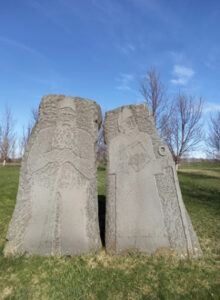
Location: Skálholt
Year: 1997
Subject: Sculpture
Materials: Greywacke sculpture.
The Artwork:
In the year 2000 the Icelandic nation celebrated 1000 years of Christianity. To celebrate the event an exhibition was held in Skálholt a few years earlier, in 1997. The theme was the conversion to Christianity in a in a broad sense. Seventeen members of the Icelandic Sculptors’ Association participated. One of them was Páll Guðmundsson from Húsafell. His sculpture juxtaposed the old heathen beliefs next to Christianity, as Thor the god of thunder and Ísleifur, the first bishop of Iceland, are put next to each other. Páll dedicated the artwork to his grandparents, Páll Guðmundsson and Rósa Eyjólfsdóttir from Hjálmstaðir in Laugardalur. He later gave the sculpture to Skálholt where it still stands between the Church and the School of Skálholt.
The Artist:
Páll Guðmundsson is a sculptor and an instrument maker. He lives in Húsafell in Borgarfjörður, a place that has a strong connection in Icelandic art history as many of our original artists would go there during summer and paint the different landscapes. Art has always been respected there and that may have been an inspiration as well as a stepping stone for Páll in his path towards becoming a successful artist. One of his most renowned pieces is a stone harp, made from thin stone tiles laid on the back and hit with a thick drumstick to make a sound. The stone-harp became world known when it was used in collaboration with the band Sigur Rós.
Concepts:
Sculpture: A three-dimensional artwork made from metal, wood or stone.
Reflections:
Artist: Páll Guðmundsson from Húsafell
Location: Skálholt
Year: 1997
Subject: Sculpture
Materials: Greywacke sculpture.
The Artwork:
In the year 2000 the Icelandic nation celebrated 1000 years of Christianity. To celebrate the event an exhibition was held in Skálholt a few years earlier, in 1997. The theme was the conversion to Christianity in a in a broad sense. Seventeen members of the Icelandic Sculptors’ Association participated. One of them was Páll Guðmundsson from Húsafell. His sculpture juxtaposed the old heathen beliefs next to Christianity, as Thor the god of thunder and Ísleifur, the first bishop of Iceland, are put next to each other. Páll dedicated the artwork to his grandparents, Páll Guðmundsson and Rósa Eyjólfsdóttir from Hjálmstaðir in Laugardalur. He later gave the sculpture to Skálholt where it still stands between the Church and the School of Skálholt.
The Artist:
Páll Guðmundsson is a sculptor and an instrument maker. He lives in Húsafell in Borgarfjörður, a place that has a strong connection in Icelandic art history as many of our original artists would go there during summer and paint the different landscapes. Art has always been respected there and that may have been an inspiration as well as a stepping stone for Páll in his path towards becoming a successful artist. One of his most renowned pieces is a stone harp, made from thin stone tiles laid on the back and hit with a thick drumstick to make a sound. The stone-harp became world known when it was used in collaboration with the band Sigur Rós.
Concepts:
Sculpture: A three-dimensional artwork made from metal, wood or stone.
Reflections:
Artist: Gerður Helgadóttir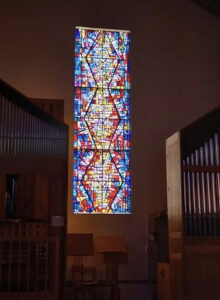
Location: Skálholt Church
Year: 1963
Subject: Stained glass window
Materials: Stained glass
The Artwork:
The windows, made by Gerður, are composed with abstract geometric forms, based on complicated formulas of forms and numbers. The idea was that the members of the church would look at all the windows as one combined artwork, playing with the light and brightness that lights up the space. This idea, to have all the fifteen windows abstract and not figurative images from the Bible, was revolutionary to Icelandic art and architecture. To some, it was a disgrace that abstract windows would decorate Skálholtskirkja, Iceland’s most sacred place. Since the Middle Ages, stained glass in European churches had depicted scenes from the Bible, so that those who could not read the written word could at least read the images before them.
The Artist:
Gerður Helgadóttir (1928-1975) was born in Tröllanes in Norðfjörður. She started studying at The Icelandic School of Art 1945, but there was no sculpture department there. In 1947 she received guidance from the sculptor Sigurjón Ólafsson and was later accepted into Denmark’s Royal Academy of Art that same year. Unfortunately, due to the war, she did not get to attend the school. She was finally accepted into a school in Italy where she studied for two years, and then headed to Paris where she studied between 1949-1950. While she was abroad she got to know many of the avant garde artists of the time. When she returned home to Iceland she brought with her fresh ideas that would influence many other Icelandic artists.
Concepts:
Figurative forms: Images based on forms of living creatures, people or animals.
Reflections:
Abstract: Artform that is not bound to a specific object or being. The viewer does not see objects that they recognise, such as a flower or a car. The art is combined of forms, colours, or lines.
Geometric forms: Images not based on living creatures but straight or curvy forms.
Artist: Gerður Helgadóttir
Location: Skálholt Church
Year: 1963
Subject: Stained glass window
Materials: Stained glass
The Artwork:
The windows, made by Gerður, are composed with abstract geometric forms, based on complicated formulas of forms and numbers. The idea was that the members of the church would look at all the windows as one combined artwork, playing with the light and brightness that lights up the space. This idea, to have all the fifteen windows abstract and not figurative images from the Bible, was revolutionary to Icelandic art and architecture. To some, it was a disgrace that abstract windows would decorate Skálholtskirkja, Iceland’s most sacred place. Since the Middle Ages, stained glass in European churches had depicted scenes from the Bible, so that those who could not read the written word could at least read the images before them.
The Artist:
Gerður Helgadóttir (1928-1975) was born in Tröllanes in Norðfjörður. She started studying at The Icelandic School of Art 1945, but there was no sculpture department there. In 1947 she received guidance from the sculptor Sigurjón Ólafsson and was later accepted into Denmark’s Royal Academy of Art that same year. Unfortunately, due to the war, she did not get to attend the school. She was finally accepted into a school in Italy where she studied for two years, and then headed to Paris where she studied between 1949-1950. While she was abroad she got to know many of the avant garde artists of the time. When she returned home to Iceland she brought with her fresh ideas that would influence many other Icelandic artists.
Concepts:
Figurative forms: Images based on forms of living creatures, people or animals.
Reflections:
Abstract: Artform that is not bound to a specific object or being. The viewer does not see objects that they recognise, such as a flower or a car. The art is combined of forms, colours, or lines.
Geometric forms: Images not based on living creatures but straight or curvy forms.
 Artist: Nína Tryggvadóttir
Artist: Nína Tryggvadóttir
Location: Skálholt Church
Year: 1965
Subject: Altarpiece
Materials: Mosaic work
The Artwork:
In 1965 Nína Tryggvadóttir’s mosaic altar piece was placed in Skálholtskirkja. Although one can clearly see an image of Christ in the artwork, it is also, a poetic interpretation of nature. In the altarpiece the colours blue, green and soft pink-brown fade into the surrounding wall. According to Nína, the idea was that Christ would appear as “a kind of a spirit in the Icelandic landscape”.
The Artist:
Nína Tryggvadóttir (1913-1968) was born in Seyðisfjörður but moved at a young age to Reykjavík with her family. In 1932 she started studying art in Reykjavík and went to Copenhagen for further education in 1935-39. After graduating she went to Paris but as the second World War was spreading over Europe she was unable to stay for long. She left for New York and studied there with Hans Hofmann. During her education she was offered to exhibit at a gallery in New York. She was also offered a set design project at The Macmillan Theatre at Columbia University in New York.
She was at that point becoming notable in the New York art scene. A few months later she married Alfred Copley, a doctor and artist, but after she returned to Iceland to gather her belongings, she was banned from re-entering the USA. When she arrived she was incarcerated on Ellis island for a few weeks before she was sent back to Iceland. As with many artists of the time, she was suspected of being a communist.
This led to the abrupt end of her rising career in New York, which was the cradle of modern art at that time. After living apart for 4 years, Nína and Alfred moved to Paris 1952 and later to London. They did not make it back to New York until 1959.
Concepts:
Figurative forms: Images based on forms of living creatures, people or animals.
Reflections:
Abstract: Artform that is not bound to a specific object or being. The viewer does not see objects that they recognise, such as a flower or a car. The art is combined of forms, colours, or lines.
Geometric forms: Images not based on living creatures but straight or curvy forms.
Artist: Nína Tryggvadóttir 
Location: Skálholt Church
Year: 1965
Subject: Altarpiece
Materials: Mosaic work
The Artwork:
n 1965 Nína Tryggvadóttir’s mosaic altar piece was placed in Skálholtskirkja. Although one can clearly see an image of Christ in the artwork, it is also, a poetic interpretation of nature. In the altarpiece the colours blue, green and soft pink-brown fade into the surrounding wall. According to Nína, the idea was that Christ would appear as “a kind of a spirit in the Icelandic landscape”.
The Artist:
Nína Tryggvadóttir (1913-1968) was born in Seyðisfjörður but moved at a young age to Reykjavík with her family. In 1932 she started studying art in Reykjavík and went to Copenhagen for further education in 1935-39. After graduating she went to Paris but as the second World War was spreading over Europe she was unable to stay for long. She left for New York and studied there with Hans Hofmann. During her education she was offered to exhibit at a gallery in New York. She was also offered a set design project at The Macmillan Theatre at Columbia University in New York.
She was at that point becoming notable in the New York art scene. A few months later she married Alfred Copley, a doctor and artist, but after she returned to Iceland to gather her belongings, she was banned from re-entering the USA. When she arrived she was incarcerated on Ellis island for a few weeks before she was sent back to Iceland. As with many artists of the time, she was suspected of being a communist.
This led to the abrupt end of her rising career in New York, which was the cradle of modern art at that time. After living apart for 4 years, Nína and Alfred moved to Paris 1952 and later to London. They did not make it back to New York until 1959.
Concepts:
Figurative forms: Images based on forms of living creatures, people or animals.
Reflections:
Abstract: Artform that is not bound to a specific object or being. The viewer does not see objects that they recognise, such as a flower or a car. The art is combined of forms, colours, or lines.
Geometric forms: Images not based on living creatures but straight or curvy forms.
Artist: Guðmundur from Miðdal. 
Location: Áshildarmýri in Skeiða- & Gnúpverjahreppur
Year: 1948
Subject: Sculpture
Materials: Stone structure, lava rocks, inscribed granite.
The Artwork:
Áshildarmýri is a large monument made from lava rocks that form the shape of a person. It is created from a drawing by the artist Guðmundur from Miðdal, and revealed in Áshildarmýri in 1948. The monument has three inscribed granite slabs in remembrance of the Áshildarmýrarsamþykkt (the Áshildarmýri Agreement) event and the men of Árnessýsla (Árnes-county) who stood up for their rights; engraved on the slabs: for the county, country, and fellow Icelanders.
The History:
While Iceland was a part of the Danish monarchy some of the Kings’ men, in powerful positions, had formed a tight friendship. Those relations started leading to injustice towards Icelanders. In 1496 the men of Árnes-county arranged to meet at Áshildarmýri in Skeiðar where they made an agreement to stop the aggression and injustice they were receiving from the Kings’ men. That agreement is Áshildarmýrarsamþykkt, (Áshildarmýri – agreement) which protects the rights of Icelanders. The agreement also prevented Icelanders from being summoned to trial in Denmark without being extradited by the Icelandic people on Alþingi. They also demanded that their lawyers and sheriff had to be Icelandic to ensure they would have fair trials.
The Artist:
Guðmundur Einarsson from Miðdal in Mosfellssveit (1895-1962) was a multi-talented artist. He worked across media and art forms including drawing, graphics, painting, sculpture, photography, film-making and writing. He was also a well known outdoor enthusiast. For many years he was a member of the board of Iceland’s travelling group and would often draw the landscape around him on his travels. When back at home he would take those landscapes and combine them together as he pleased, so he could end up with a painting of a mountain from the West of Iceland with a waterfall from the South.
Concepts:
Monument: An artwork in any form that is made to remember a significant person or event in history that should never be forgotten.
Reflections:
If you could rearrange nature, what landscape would you combine in a picture? What public artwork would you put in that picture?
Artist: Guðmundur from Miðdal. 
Location: Áshildarmýri in Skeiða- & Gnúpverjahreppur
Year: 1948
Subject: Sculpture
Materials: Stone structure, lava rocks, inscribed granite.
The Artwork:
Áshildarmýri is a large monument made from lava rocks that form the shape of a person. It is created from a drawing by the artist Guðmundur from Miðdal, and revealed in Áshildarmýri in 1948. The monument has three inscribed granite slabs in remembrance of the Áshildarmýrarsamþykkt (the Áshildarmýri Agreement) event and the men of Árnessýsla (Árnes-county) who stood up for their rights; engraved on the slabs: for the county, country, and fellow Icelanders.
The History:
While Iceland was a part of the Danish monarchy some of the Kings’ men, in powerful positions, had formed a tight friendship. Those relations started leading to injustice towards Icelanders. In 1496 the men of Árnes-county arranged to meet at Áshildarmýri in Skeiðar where they made an agreement to stop the aggression and injustice they were receiving from the Kings’ men. That agreement is Áshildarmýrarsamþykkt, (Áshildarmýri – agreement) which protects the rights of Icelanders. The agreement also prevented Icelanders from being summoned to trial in Denmark without being extradited by the Icelandic people on Alþingi. They also demanded that their lawyers and sheriff had to be Icelandic to ensure they would have fair trials.
The Artist:
Guðmundur Einarsson from Miðdal in Mosfellssveit (1895-1962) was a multi-talented artist. He worked across media and art forms including drawing, graphics, painting, sculpture, photography, film-making and writing. He was also a well known outdoor enthusiast. For many years he was a member of the board of Iceland’s travelling group and would often draw the landscape around him on his travels. When back at home he would take those landscapes and combine them together as he pleased, so he could end up with a painting of a mountain from the West of Iceland with a waterfall from the South.
Concepts:
Monument: An artwork in any form that is made to remember a significant person or event in history that should never be forgotten.
Reflections:
If you could rearrange nature, what landscape would you combine in a picture? What public artwork would you put in that picture?
Artists: Elísabet K. Jökulsdóttir &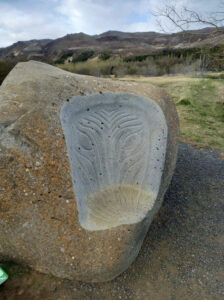
Matthías Rúnar Sigurðsson
Location: Varmá in Hveragerði
Year: 2019
Subject: Sculpture
Materials: Dolerite Sculpture.
The Artwork:
Þetta líður hjá (This will pass) is a 12-ton rock of dolerite lava from Mount Núpi. The artist Elísabet had the rock moved to the riverbank of Hvítá. Matthías Rúnar Sigurðsson, Sculptor, carved the seat in it. “It is a seat that stands by the river Varmá, where you can sit if you are not feeling well, then it will all pass by, just like the river,” says Elísabet.
“The artwork is about the friendship and our relationship with nature. And what nature wants to tell us at our weaker moments. And that it’s alright for us to live with our emotions.”
The artist dedicates this work to teenagers.
The Artists:
Elísabet graduated from Kvennaskólinn í Reykjavík in 1987. After that she studied screenwriting and has a BA diploma in stage-art from Iceland University of the Arts from 2008.
Elísabet has worked as a journalist, she is an active speaker for the environment and amongst other things she ran for president in 2016. She has received many rewards for her poems, short stories, novels and plays as well as having been nominated for the Nordic Council Literature Prize.
The artist Matthías Rúnar Sigurðsson graduated from Iceland University of Arts in 2013. At the beginning of his career he worked mostly with drawings but soon became interested in sculpture. The interest derived from a book about ancient art in which many of the pieces were sculptures, making him consider what could be done today with modern technology if that could be achieved thousands of years ago. Matthías started his art making with a hammer and chisel, which was highly time consuming but he now works with electric tools such as a grinder and a handheld milling machine, which speeds up the whole process.
Concepts:
Sculpture: A three-dimensional artwork made from metal, wood or stone.
Dolerite: A lava formation that surfaced about 3.3 million years ago. The Dolerite in Reykjavík is mainly lava from the later part of the last ice age 700.000-100.000 years ago.
Reflections:
Few things are as nice as sitting in peace by a river, listening to it passing by. Please have a seat and enjoy.
Think also of another place that you feel comfortable in, where you feel completely safe and secure.
Artists: Elísabet K. Jökulsdóttir & 
Matthías Rúnar Sigurðsson
Location: Varmá in Hveragerði
Year: 2019
Subject: Sculpture
Materials: Dolerite Sculpture.
The Artwork:
Þetta líður hjá (This will pass) is a 12-ton rock of dolerite lava from Mount Núpi. The artist Elísabet had the rock moved to the riverbank of Hvítá. Matthías Rúnar Sigurðsson, Sculptor, carved the seat in it. “It is a seat that stands by the river Varmá, where you can sit if you are not feeling well, then it will all pass by, just like the river,” says Elísabet.
“The artwork is about the friendship and our relationship with nature. And what nature wants to tell us at our weaker moments. And that it’s alright for us to live with our emotions.”
The artist dedicates this work to teenagers.
The Artists:
Elísabet graduated from Kvennaskólinn í Reykjavík in 1987. After that she studied screenwriting and has a BA diploma in stage-art from Iceland University of the Arts from 2008.
Elísabet has worked as a journalist, she is an active speaker for the environment and amongst other things she ran for president in 2016. She has received many rewards for her poems, short stories, novels and plays as well as having been nominated for the Nordic Council Literature Prize.
The artist Matthías Rúnar Sigurðsson graduated from Iceland University of Arts in 2013. At the beginning of his career he worked mostly with drawings but soon became interested in sculpture. The interest derived from a book about ancient art in which many of the pieces were sculptures, making him consider what could be done today with modern technology if that could be achieved thousands of years ago. Matthías started his art making with a hammer and chisel, which was highly time consuming but he now works with electric tools such as a grinder and a handheld milling machine, which speeds up the whole process.
Concepts:
Sculpture: A three-dimensional artwork made from metal, wood or stone.
Dolerite: A lava formation that surfaced about 3.3 million years ago. The Dolerite in Reykjavík is mainly lava from the later part of the last ice age 700.000-100.000 years ago.
Reflections:
Few things are as nice as sitting in peace by a river, listening to it passing by. Please have a seat and enjoy.
Think also of another place that you feel comfortable in, where you feel completely safe and secure.
Artist: Brynhildur Þorgeirsdóttir 
Location: Listasafn Árnesinga
Year: 2018
Subject: sculpture
The Artwork:
Árnesingur, a sculpture of a mountain located in front of the entrance to LÁ Art Museum and is a part of the Museum collection. The artwork is large and of a rugged construction, yet a certain softness emanates from the purple glass spikes on top of it. The artist Brynhildur Þorgeirsdóttir is a pioneer in Icelandic sculpture, as she is known for mixing “punk” in her artwork, noted here in the added spikes. She works with glass and sand as well as other industrial materials, echoing the natural forms that appear in her artwork in an adventurous yet realistically calm way.
The Artist:
Brynhildur Þorgeirsdóttir was born in Hrafnkelsstaðir in Hrunamannahreppur in Árnessýsla. Art was well tolerated in her home and she was encouraged by her mother to study art, in the hope that she would one day teach drawing. Brynhildur did study art at The Icelandic School of Art, graduating in 1978. However, she did not start teaching but went abroad to Amsterdam and California for further education. She also went to Sweden where she studied the art of glass, which she has used in her art ever since. Her artwork has been described as “punk and rugged” but she maintains her character as a calm country girl and even though her artwork has glass spikes in them, they are as harmless just as herself.
Concepts:
Punk: Rough Rock and Roll music that was popular in the 80s, characterized by loud and simple play of instruments and even singing out of tune. Around this music developed a Counter-culture that appeared in their follower’s lifestyle as well as their style of clothing. Their signature look was torn clothes and conspicuous hairstyles, such as the iconic Mohawk.
A realistic calm way: To relate to Earth and Nature, like landscape and mountains.
Sculpture: A three-dimensional artwork made from metal, wood or stone.
Reflections:
In Bankastræti, a street in down-town Reykjavík, is a museum dedicated to Punk-music and is worth the visit.
Next time you go to a beach it might be fun to think of Árnesingur and build your own model of it using seashells and pebbles to form the spikes on top.
Artist: Brynhildur Þorgeirsdóttir 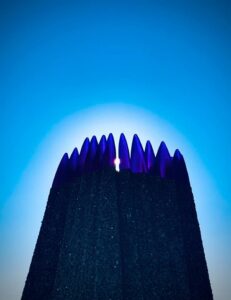
Location: Listasafn Árnesinga
Year: 2018
Subject: sculpture
The Artwork:
Árnesingur, a sculpture of a mountain located in front of the entrance to LÁ Art Museum and is a part of the Museum collection. The artwork is large and of a rugged construction, yet a certain softness emanates from the purple glass spikes on top of it. The artist Brynhildur Þorgeirsdóttir is a pioneer in Icelandic sculpture, as she is known for mixing “punk” in her artwork, noted here in the added spikes. She works with glass and sand as well as other industrial materials, echoing the natural forms that appear in her artwork in an adventurous yet realistically calm way.
The Artist:
Brynhildur Þorgeirsdóttir was born in Hrafnkelsstaðir in Hrunamannahreppur in Árnessýsla. Art was well tolerated in her home and she was encouraged by her mother to study art, in the hope that she would one day teach drawing. Brynhildur did study art at The Icelandic School of Art, graduating in 1978. However, she did not start teaching but went abroad to Amsterdam and California for further education. She also went to Sweden where she studied the art of glass, which she has used in her art ever since. Her artwork has been described as “punk and rugged” but she maintains her character as a calm country girl and even though her artwork has glass spikes in them, they are as harmless just as herself.
Concepts:
Punk: Rough Rock and Roll music that was popular in the 80s, characterized by loud and simple play of instruments and even singing out of tune. Around this music developed a Counter-culture that appeared in their follower’s lifestyle as well as their style of clothing. Their signature look was torn clothes and conspicuous hairstyles, such as the iconic Mohawk.
A realistic calm way: To relate to Earth and Nature, like landscape and mountains.
Sculpture: A three-dimensional artwork made from metal, wood or stone.
Reflections:
In Bankastræti, a street in down-town Reykjavík, is a museum dedicated to Punk-music and is worth the visit.
Next time you go to a beach it might be fun to think of Árnesingur and build your own model of it using seashells and pebbles to form the spikes on top.
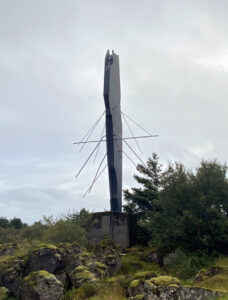 Artist: Sigurjón Ólafsson
Artist: Sigurjón Ólafsson
Location: Intersection between Stokkseyri and Eyrarbakki
Year: 1981
Subject: Sculpture
Materials: Metal sculpture
The Artwork:
Krían (the Arctic Tern) is a metal sculpture in a forest area between Eyrarbakki and Stokkseyri. It is 14 meters high and can be seen clearly from a distance. The artwork is combined with different forms. It consists of a vertical thick centerpiece made from metal. Emerging from it are iron rods with little circular forms at the end of them. Krían was raised in memory of Ragnar Jónsson (Ragnar í Smára) from Eyrarbakki. Ragnar was a connoisseur of art and bought many paintings from Icelandic artists. He gave a part of his collection to The Icelandic Confederation of Labour The People’s Union of Iceland which later became the foundation of The ASÍ Art Museum. Ragnar’s contribution meant a lot to Icelandic art and he deserves a big art memorial such as this one. Krían was erected in 1981 in a forest area that Ragnar’s mother gave to the municipality of Eyrarbakki, with the terms of the municipality setting up a sculpture garden there.
The Artist:
Sigurjón Ólafsson was born in Eyrarbakki in 1908. He got his first art tutorial from Ásgrímur Jónsson, one of Iceland’s first painters, and later studied with the sculptor Einar Jónsson. He went to Copenhagen to study in 1928 and in 1930 he won a gold prize for one of his artworks. Sigurjón did not return to Iceland until after the war. During his time abroad he made friends with many of the avant garde artists of that time, and had become one himself. He was a true pioneer of Icelandic abstract art when he returned home. At the beginning of his career, he mainly worked with stone sculptures, but his lungs could not handle the fine dust that came with it. He was then forced to find another medium and started working with metal and wood. After that and through the rest of his career his artwork became much lighter.
Concepts:
Sculpture: A three-dimensional artwork made from metal, wood, or stone.
Monument: An artwork in any form that is made to remember a significant person or event in history that should never be forgotten.
Comments:
Access to the artwork is hard. There is nowhere to park a car in a comfortable distance from it and there is no trail that leads to it.
Artist: Sigurjón Ólafsson 
Location: Intersection between Stokkseyri and Eyrarbakki
Year: 1981
Subject: Sculpture
Materials: Metal sculpture
The Artwork:
Krían (the Arctic Tern) is a metal sculpture in a forest area between Eyrarbakki and Stokkseyri. It is 14 meters high and can be seen clearly from a distance. The artwork is combined with different forms. It consists of a vertical thick centerpiece made from metal. Emerging from it are iron rods with little circular forms at the end of them. Krían was raised in memory of Ragnar Jónsson (Ragnar í Smára) from Eyrarbakki. Ragnar was a connoisseur of art and bought many paintings from Icelandic artists. He gave a part of his collection to The Icelandic Confederation of Labour The People’s Union of Iceland which later became the foundation of The ASÍ Art Museum. Ragnar’s contribution meant a lot to Icelandic art and he deserves a big art memorial such as this one. Krían was erected in 1981 in a forest area that Ragnar’s mother gave to the municipality of Eyrarbakki, with the terms of the municipality setting up a sculpture garden there.
The Artist:
Sigurjón Ólafsson was born in Eyrarbakki in 1908. He got his first art tutorial from Ásgrímur Jónsson, one of Iceland’s first painters, and later studied with the sculptor Einar Jónsson. He went to Copenhagen to study in 1928 and in 1930 he won a gold prize for one of his artworks. Sigurjón did not return to Iceland until after the war. During his time abroad he made friends with many of the avant garde artists of that time, and had become one himself. He was a true pioneer of Icelandic abstract art when he returned home. At the beginning of his career, he mainly worked with stone sculptures, but his lungs could not handle the fine dust that came with it. He was then forced to find another medium and started working with metal and wood. After that and through the rest of his career his artwork became much lighter.
Concepts:
Sculpture: A three-dimensional artwork made from metal, wood, or stone.
Monument: An artwork in any form that is made to remember a significant person or event in history that should never be forgotten.
Comments:
Access to the artwork is hard. There is nowhere to park a car in a comfortable distance from it and there is no trail that leads to it.
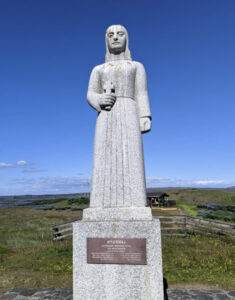 Artist: Gunnfríður Jónsdóttir
Artist: Gunnfríður Jónsdóttir
Location: Strandarkirkja, Engilvík in Selvogur.
Year: 1940
Subject: sculpture
Materials: granite sculpture
The Artwork:
Landsýn (Land-view) was erected in memory of sailors who made it to land through a bad storm. On a dark, stormy night when the sea was so rough that the men feared for their lives, the sailors knelt and prayed to Mother Mary and vowed that if they made it alive, they would build a church on the spot where they reached land, with the wood they had on board. At that moment, a bright light appeared on the shore and guided them to safety. Landsýn is located next to the church Strandarkirkja that they went on to build. When the artist Gunnfríður visited the church for the first time, knowing the story, it was the feeling of emptiness/loneliness that struck her the most. Years later when Landsýn was shipped to Iceland from Norway, she was determined it would stand next to the church, and honour the memory of the sailors who survived.
The Artist:
Gunnfríður Jónsdóttir (1889-1968) was from the town Kirkjubær in Húnavatnssýsla. At the age of 19 she went to the Girls’ School in Blönduós and after that studied dress making. In 1919 she sailed to Stockholm where she worked for wealthy families and had a good income. On her way to Stockholm, she met the sculptor Ásmundur Sveinsson who she married in 1924. While he finished his studies, she worked and was the main source of income for them. When they arrived back in Iceland, they lived and worked at Freyjugata 42, which today is the museum Ásmundarsalur. Gunnfríður passed away in 1968 and is buried in Strandarkirkja cemetery.
Concepts:
Sculpture: A three-dimensional artwork made from metal, wood or stone.
Reflections:
Artist: Gunnfríður Jónsdóttir 
Location: Strandarkirkja, Engilvík in Selvogur.
Year: 1940
Subject: sculpture
Materials: granite sculpture
The Artwork:
Landsýn (Land-view) was erected in memory of sailors who made it to land through a bad storm. On a dark, stormy night when the sea was so rough that the men feared for their lives, the sailors knelt and prayed to Mother Mary and vowed that if they made it alive, they would build a church on the spot where they reached land, with the wood they had on board. At that moment, a bright light appeared on the shore and guided them to safety. Landsýn is located next to the church Strandarkirkja that they went on to build. When the artist Gunnfríður visited the church for the first time, knowing the story, it was the feeling of emptiness/loneliness that struck her the most. Years later when Landsýn was shipped to Iceland from Norway, she was determined it would stand next to the church, and honour the memory of the sailors who survived.
The Artist:
Gunnfríður Jónsdóttir (1889-1968) was from the town Kirkjubær in Húnavatnssýsla. At the age of 19 she went to the Girls’ School in Blönduós and after that studied dress making. In 1919 she sailed to Stockholm where she worked for wealthy families and had a good income. On her way to Stockholm, she met the sculptor Ásmundur Sveinsson who she married in 1924. While he finished his studies, she worked and was the main source of income for them. When they arrived back in Iceland, they lived and worked at Freyjugata 42, which today is the museum Ásmundarsalur. Gunnfríður passed away in 1968 and is buried in Strandarkirkja cemetery.
Concepts:
Sculpture: A three-dimensional artwork made from metal, wood or stone.
Reflections:
Design and concept: Max Riley & Kristín Scheving
Illustrations: Tomy Croze
Text by: Ásta Friðriksdóttir, art historian.
Proof read: Viktor Pétur Hannesson, art historian.
Supported by: South Iceland Development Fund.


